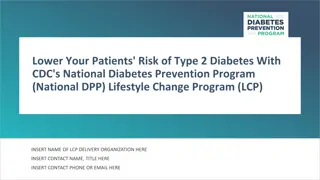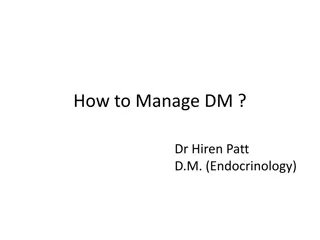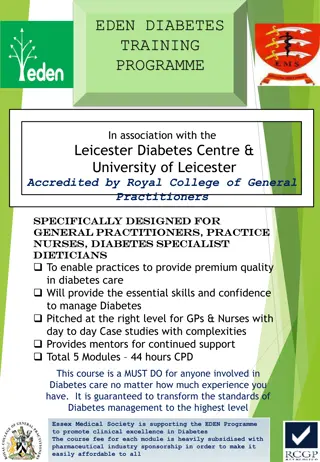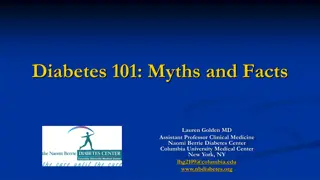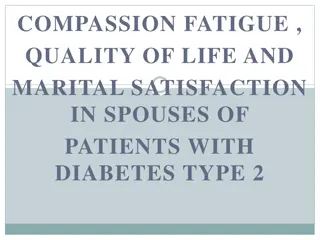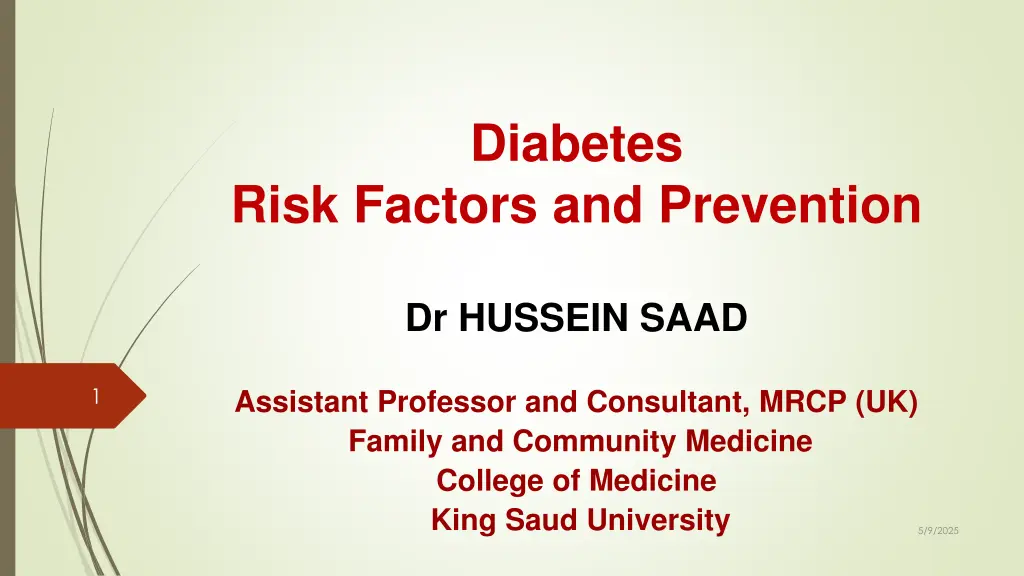
Diabetes Risk Factors, Prevention, and Epidemiology Overview
Explore the risk factors, complications, preventive measures, and epidemiological insight into diabetes by Dr. Hussein Saad, an Assistant Professor and Consultant. Learn about the classification, diagnostic criteria for diabetes and prediabetes, and screening programs in Saudi Arabia. Gain valuable knowledge on testing for diabetes in asymptomatic adults and more.
Download Presentation

Please find below an Image/Link to download the presentation.
The content on the website is provided AS IS for your information and personal use only. It may not be sold, licensed, or shared on other websites without obtaining consent from the author. If you encounter any issues during the download, it is possible that the publisher has removed the file from their server.
You are allowed to download the files provided on this website for personal or commercial use, subject to the condition that they are used lawfully. All files are the property of their respective owners.
The content on the website is provided AS IS for your information and personal use only. It may not be sold, licensed, or shared on other websites without obtaining consent from the author.
E N D
Presentation Transcript
Diabetes Risk Factors and Prevention Dr HUSSEIN SAAD 1 Assistant Professor and Consultant, MRCP (UK) Family and Community Medicine College of Medicine King Saud University 5/9/2025
OBJECTIVES 2 List the risk factors of diabetes List complications of diabetes Discuss preventive measures within the framework of NCDs Screening of Diabetes Prevention programs in KSA 5/9/2025
Epidemiology 3 The studies demonstrated varying prevalence rates in different geographical regions in the country, ranging from 18.2% (in 2004 2005) in the study conducted in the Eastern province to 31.6% in 2011 in the study conducted in Riyadh. Incidence and prevalence rates of diabetes mellitus in Saudi Arabia: An overview Abdulellah Alotaibi LinPerryLeilaGholizadehAliAl-Ganmi Journal of Epidemiology and Global Health Volume 7, Issue 4, December 2017, Pages 211-218 5/9/2025
CLASSIFICATION of DIABETES 4 Type 1 diabetes (due to autoimmune -cell destruction, usually leading to absolute insulin deficiency) Type 2 diabetes (due to a progressive loss of -cell insulin secretion frequently on the background of insulin resistance) Gestational diabetes mellitus (GDM) (diabetes diagnosed in the second or third trimester of pregnancy that was not present prior to gestation) Specific types of diabetes due to other causes, e.g. maturity-onset diabetes of the young [MODY]), and drug induced diabetes (such as with glucocorticoid use,) 5/9/2025
Criteria for the Diagnosis of Diabetes 5 FPG:126 mg/dL (7.0 mmol/L). Fasting for at least 8 h. OR 2-h PP: 200 mg/dL (11.1 mmol/L). OR A1C 6.5%. OR In a patient with classic symptoms of hyperglycemia and a random plasma glucose 200 mg/dL (11.1 mmol/L). In the absence of unequivocal hyperglycemia, diagnosis requires two abnormal test results from the same sample or in two separate test samples. 5/9/2025
Criteria for the Diagnosis of Prediabetes 6 Normal Fasting Plasma Glucose: 5.5 mmol/L (99 mg/dL) Prediabetes; Fasting Plasma Glucose: 5.6 6.9 mmol/L (100 - 125 mg/dL) Prediabetes; A1C: 5.7 6.4% The person is at risk to develop diabetes mellitus 5/9/2025
Criteria for testing for diabetes in asymptomatic adults 7 1. Testing should be considered in overweight or obese adults who have one or more of the following risk factors: a. First-degree relative with diabetes b. History of CVD or Hypertension c. Women with polycystic ovary syndrome d. Physical inactivity e. Conditions associated with insulin resistance (e.g., severe obesity, acanthosis nigricans) 2. Patients with prediabetes should be tested yearly. 3. Women who were diagnosed with GDM. 4. For all other patients, testing should begin at age 45 years. 5. If results are normal, testing should be repeated at a minimum of 3-year intervals 5/9/2025
8 5/9/2025
Prevention or Delay Development of Diabetes 9 The Diabetes Prevention Program Several major randomized controlled trials, including: 1. Diabetes Prevention Program (DPP), 2. Finnish Diabetes Prevention Study (DPS), 3. Da Qing Diabetes Prevention Study (Da Qing study) All demonstrated that lifestyle/ behavioral therapy featuring an individualized reduced calorie meal plan is highly effective in preventing type 2 diabetes and improving other cardiometabolic markers (such as blood pressure, lipids, and inflammation). The strongest evidence for diabetes prevention comes from the DPP trial (1). The DPP demonstrated that an intensive lifestyle intervention could reduce the incidence of type 2 diabetes by 58% over 3 years. 5/9/2025
Prevention or Delay Development of Diabetes 10 LIFESTYLE INTERVENTIONS Refer patients with prediabetes to an intensive behavioral lifestyle intervention program. Based on the Diabetes Prevention Program (DPP) to achieve PREVENTION OR DELAY OF TYPE 2 DIABETES and maintain 7 - 10% loss of initial body weight and increase moderate-intensity physical activity (such as brisk walking) to at least 150 min/week. (Evidence: A) 5/9/2025
Healthy Nutrition 11 Encourage: Whole grains, legumes, nuts, fruits and vegetables. Minimize; refined and processed foods, like rice, white bread, sugary drinks, The use of nonnutritive sweeteners may have the potential to reduce overall calorie and carbohydrate intake if substituted for caloric (sugar) sweeteners. 5/9/2025
Healthy Nutrition 12 A referral to dietitian is essential to assess the overall nutrition status of, and to work collaboratively with, the patient to create a personalized meal plan that considers the individual s health status, skills, resources, food preferences, and health goals to coordinate and align with the overall treatment plan including physical activity and medication. 5/9/2025
Physical Activity 13 Just as 150 min/week of moderate intensity physical activity, such as brisk walking, showed beneficial effects in those with prediabetes. Moderate intensity physical activity has been shown to improve insulin sensitivity and reduce abdominal fat. 5/9/2025
Tobacco Cessation 14 Tobacco Smoking may increase the risk of type 2 diabetes; therefore, evaluation for tobacco use and referral for tobacco cessation, if indicated, should be part of routine care for those at risk for diabetes. 5/9/2025
Pharmacologic Interventions 15 Metformin therapy for prevention of type 2 diabetes should be considered in those with prediabetes, especially for those who are obese. Metformin and intensive lifestyle modification led to an equivalent 50% reduction in diabetes risk. 5/9/2025
Complications of DM 16 After 10 years of observational follow-up of the UKPDS, those originally randomized to intensive glycemic control had significant long-term reductions in MI (15% with sulfonylurea or insulin as initial pharmacotherapy, 33% with metformin as initial pharmacotherapy) and in all-cause mortality (13% and 27%, respectively). DM increase risk of CVD. 5/9/2025
Complications of DM 17 Chronic kidney disease Optimize glucose control to reduce the risk or slow the progression of chronic kidney disease. A Optimize blood pressure control to reduce the risk or slow the progression of chronic kidney disease. A Screening by Albumin/Creatinine Ratio to detect Microalbuminuria beside Renal function tests. 5/9/2025
Complications of DM 18 Diabetic Retinopathy Optimize glycemic control to reduce the risk or slow the progression of diabetic retinopathy. A Optimize blood pressure and serum lipid control to reduce the risk or slow the progression of diabetic retinopathy. A Screening for Retinopathy: Adults with type 1 diabetes should be referred to an ophthalmologist within 5 years after the onset of diabetes. B Patients with type 2 diabetes should be referred to an ophthalmologist at the time of the diabetes diagnosis. B 5/9/2025
Complications of DM 19 Neuropathy Screening All patients should be assessed for diabetic peripheral neuropathy starting at diagnosis of type 2 diabetes and 5 years after the diagnosis of type 1 diabetes and at least annually thereafter. B 5/9/2025
Complications of DM 20 Foot care & Diabetic foot Perform a comprehensive foot evaluation at least annually to identify risk factors for ulcers and amputations. B The examination should include inspection of the skin, assessment of foot deformities, neurological assessment (monofilament testing with pinprick, temperature, vibration), and vascular assessment including pulses in the legs and feet. B 5/9/2025
Prevention / Health Services in Saudi Arabia 21 Specialized Centers: The Ministry of Health (MOH) adopted implementing an objective method in all the fields of health services providing: prevention, treatment, and rehabilitation, through a network of integrated facilities. Thus, it established 20 specialized centers for treating diabetics, and eight new more centers are underway across the Saudi Arabia's regions. Further, the MOH is working on enhancing the health awareness of each diabetic or anyone vulnerable to develop the disease, and providing the best health and education services. 5/9/2025
Referral of diabetic patients: 22 To Eye Clinic: ( DM type 2 first visit and DM type 1 after 5 years of diagnosis. To Dietitian: for all To Diabetic Educator: when start insulin or shift to Penfill injections. To Specialty Clinics: like nephrology when indicated All patients on insulin will be offered a Glucometer for home monitoring. Multidisciplinary approach for DIABETIC PATIENTS (Physician, clinical pharmacist, health educator and nutritionist) 5/9/2025
The National Executive Plan Includes Seven Objectives: 23 First Objective: the primary prevention from the second type of diabetes, and diminishing incidence rates of the disease through addressing the risk factors causing the disease. Second Objective: secondary prevention from the second type of diabetes through the early detection of the disease and its complications. Third Objective: advancing quality of the health services delivered to the patients suffering from diabetes and its complications. Fourth Objective: developing ways of detecting and following up, and assessing patients through Diabetics' Registration Program, extent of adherence to the work quality levels, annual follow-up registers, patients' interviews, and healthcare registers of patients. Fifth Objective: improving on the research tools and studies related to the disease. Sixth Objective: enabling diabetics and their families to contribute to controlling diabetes and its complications. Seventh Objective: community participation in controlling diabetes. 5/9/2025
World Diabetes Day: 24 The Ministry of Health (MOH) is interested annually in marking the World Diabetes Day, falling on the fourteenth of November of each year. This is with the aim of achieving the general goals in terms of boosting up and carrying out the prevention policies and controlling diabetes and its complications. Supporting the national initiatives for diabetes control and its complications, and highlighting the importance of evidence- based education with regard to treating diabetes and preventing from its complications. 5/9/2025
National Preventive Programs 25 The cornerstone of a national preventive program would be the PHCCs. However, quality of care at the PHCCs is unsatisfactory. A comprehensive review of primary healthcare in Saudi Arabia found that access to health education was limited and referrals to specialist hospitals were low. Patients follow-up system was ineffective. Multiple problems with poor quality and time for health education, poor counseling, lack of trust in health-care providers, and difficulty in understanding instructions from health providers due to poor communication. 5/9/2025



